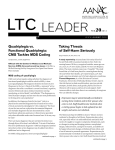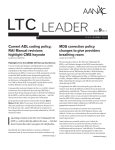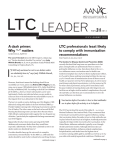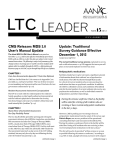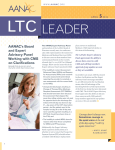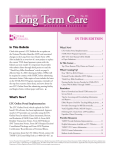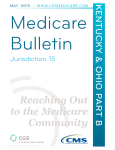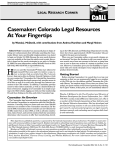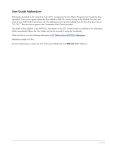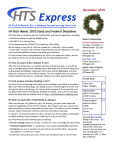Download LEADER
Transcript
LTC LEADER jan 08 2 014 w w w. a a n ac .o r g Individualization, complexity drive skilled maintenance coverage Caralyn Davis, ba, staff writer On Dec. 19, 2013, the Centers for Medicare and Medicaid Services held an MLN Connects National Provider Call (NPC) to discuss Transmittal 176 (change request 8458), which updates the CMS online manual system to clarify Medicare coverage for the skilled nursing facility, inpatient rehabilitation facility, home health, and outpatient therapy (i.e., Medicare Part B therapy) benefits pursuant to the Jan. 24, 2013, Jimmo v. Sebelius settlement agreement. The clarifications include updates to Chapter 8, “Coverage of Extended Care (SNF) Services,” and Chapter 15, “Covered Medical and Other Health Services,” which discusses coverage of Part B therapy services, in the Medicare Benefit Policy Manual. “When skilled nursing or skilled therapy services are required in order to provide care that is reasonable and necessary to prevent or slow further deterioration, coverage cannot be denied based on the absence of improvement or restoration potential.” “The goal of the settlement agreement is to ensure that claims are correctly adjudicated in accordance with Medicare policy,” said agency officials. However, the agreement doesn’t open the door wide for an influx of new Medicare beneficiaries in any of the impacted care settings because no existing Medicare coverage requirements actually changed. “The settlement agreement includes language specifying that nothing in the settlement agreement modifies, contracts, or expands the existing eligibility requirements for receiving Medicare coverage,” stressed officials. “Accordingly, any actions undertaken in connection with this settlement do not represent an expansion or contraction of coverage.” continued on page 3 Re visiting the most-re ad article of 2013: Section M: Is your assessment system up to par? Caralyn Davis, ba, staff writer When the Centers for Medicare and Medicaid Services (CMS) updates the RAI User’s Manual for the MDS 3.0, it’s easy to fall into the trap of doing a quick skim of the changes without ever making time for an in-depth review. However, the overall focus of V1.10 of the RAI Manual is guiding providers to conduct: (1) a specific, holistic resident assessment process and (2) root-cause analysis leading to the development of performance improvement plans, suggests Judi Kulus, nha, rn, mat, c-ne, rac-mt, vice president of curriculum development at AANAC. “The principles of QAPI (quality assurance and performance improvement) are going to have a direct correlation to how we analyze and improve our systems to effect positive outcomes.” The May update to Section M (skin conditions) provides a good example of how and why a more detailed manual read-through can benefit MDS coordinators and the interdisciplinary team (IDT), putting them on the path to “refining their assessment systems and using their critical thinking skills to support resident outcomes in a very powerful way,” says Kulus. “Pressure ulcer staging is a clinical system, and the manual now guides us to take a look at whether that system is functioning whenever pressure ulcers worsen or develop.” Key changes to consider include the following: Cartilage counts as bone. The May update provides a significant level of guidance for pressure ulcer assessment throughout Section M, says Kulus. In M0300 (current number of unhealed pressure ulcers at each stage), CMS clarified that cartilage counts as bone for pressure ulcer assessment. continued on page 5 Dementia care partnership The Nov. 25 MLN Connects National Provider Call on the National Partnership to Improve Dementia Care was a main focus of this ODF, with CMS contractors highlighting and updating information provided during the earlier call. The “fundamental goal” of the partnership is “to use person-centered care principles and individualized care planning to improve dementia care for all of the people living in nursing homes in the United States,” pointed out officials. The starting point is CMS’ wellpublicized drive to reduce the prevalence of antipsychotic medication use in long-stay nursing home residents by 15 percent nationally—a goal that has yet to be met. Thus far, nursing homes across the country have achieved an 11.4 percent reduction, said officials. “Many states have had rates that are a lot higher than that, up to 25 percent or more improvement, but there are still some states that have had only a 3 percent or 4 percent change,” they noted. “So every region has seen some improvement, but some states have seen much more improvement than others.” Peer-to-peer mentoring, which is available via the state coalitions, and provider outreach have reaped some insights from the field that CMS officials felt were worth sharing. These include the importance of the following: Identifying good candidates for medication reduction. “If you are looking for a tool that you can use to identify individual residents who might be good candidates for gradual dose reduction and to come up with a systematic plan for how to do that throughout your facility,” the Advancing 2 AANAC.org | 800.768.1880 Excellence in America’s Nursing Homes’ Dementia Care Partnership page is a good place to visit, said officials. Note: Start by browsing under the heading “Individual Tools and How-To’s.” Pain and sleep assessments. For residents with dementia, focusing on the assessment of pain and sleep hygiene often significantly reduced “a lot of the behavioral responses and distress that they were seeing,” said officials. “That is one of the ways providers have been able to reduce or eliminate antipsychotic medications in people with dementia. It seems to be a best practice.” member can know every resident as well as they might like, or there might be temporary staff in the building. So for the DON to make sure that information about an individual resident is conveyed to anyone who might be putting out a call to a prescriber is very important.” Establishing efficacy of nonpharmacologic interventions. Many providers are asking: “What is the evidence for different interventions? How do we know these approaches will work?” said officials. Promoting Positive Behavioral Health: A Non-pharmacologic Toolkit for Senior Living Communities Building a relationship—going over to the hospital—has been very effective in making sure that fewer people come out on an antipsychotic. DON leadership. “Some directors of nursing around the country have stepped up and said, ‘I feel that as the nursing leader in this facility, it is my responsibility to bring the team together, talk with the medical director about prescribing practices in the building, and talk with the individual prescribers—nurse practitioners, physician assistants, and physicians— to make sure they are following CMS regulations with respect to F329 (unnecessary drugs),’” related officials. Also, when a resident with dementia experiences a change in condition, “a number of DONs are asking their floor nurses and charge nurses to call the DON first before calling a prescriber,” said officials. The point is to “talk through the case and talk through the nonpharmacologic interventions that might be put in place that would be individualized for a particular resident,” they explained. “Not every single staff (aka Nursing Home Toolkit) reviews the evidence for many nonpharmacologic interventions. For example, the “Nonpharmacologic Approaches” section under the “Toolkit” tab contains a literature review of the most effective nonpharmacologic approaches and two tables explaining each approach and examining its efficacy and feasibility. A strong relationship with acute care. Although many nursing home residents with dementia arrive from the hospital already on an antipsychotic, “it isn’t always clear from the hospital documentation why they are on an antipsychotic,” said officials. “Building a relationship—going over to the hospital and having a meeting or having a conference call—has been very effective in making sure that fewer people come out on an antipsychotic unless there is a very clear clinical indication documented in the record.” continued on page 7 A A N AC LT C L E A D E R 01. 0 8 . 2 014 © 2014 AANAC. No part of this publication may be reproduced without written permission from AANAC. The information presented is informative and does not constitute direct legal or regulatory advice. Individualization, complexity drive skilled maintenance coverage, continued from page 1 Instead, the changes clarify existing policy as follows: “When skilled nursing or skilled therapy services are required in order to provide care that is reasonable and necessary to prevent or slow further deterioration, coverage cannot be denied based on the absence of improvement or restoration potential. Conversely, such coverage would not be available when the beneficiary’s care needs can be met safely and effectively through the use of non-skilled personnel,” explained officials. “When we are discussing coverage, we are primarily talking about the specific coverage requirement that the services rendered must be considered skilled services. Of course, all other coverage requirements for the individual setting must be met as well in order for the claim to be covered.” What about the improvement standard? In determining Medicare coverage for maintenance claims that require skilled care, “no improvement standard is to be applied,” said officials. “Skilled nursing or therapy services are covered where such services are necessary to maintain the patient’s current condition or to prevent or slow further deterioration. This means that the beneficiary must not only require maintenance care but must require skilled involvement in order for the needed care to be furnished safely and effectively.” To clarify, “in the maintenance context, coverage of skilled nursing and skilled therapy services does not turn on the presence or absence of a beneficiary’s potential for improvement,” stated officials. “Rather, coverage turns on the beneficiary’s need for skilled care, as well as the underlying reasonableness and necessity of the services themselves. Any Medicare coverage or appeals decisions concerning skilled care coverage must reflect this basic principle.” However, an improvement standard should be applied in situations where the treatment goal is restorative, said officials. In evaluating a claim for skilled services that are restorative (i.e., the purpose is partially or completely reversing a previous loss of function), “it would be appropriate to consider the beneficiary’s potential for improvement for those services,” they explained. SNFs should take note that this standard applies for restorative skilled nursing or skilled therapy provided under Medicare Part A, as well as Part B therapy. Note: Documentation in the medical record should clearly indicate “whether or not the services provided will come with a goal of restoration or a goal of maintenance,” said officials. What makes maintenance skilled? Maintenance services are defined as services that are necessary to maintain a person’s condition or to prevent or slow further deterioration. The manual clarifications address “in what instance would maintenance services be considered skilled and therefore meet the skilled coverage requirement,” said officials. “Sometimes, even though no improvement is expected, a patient’s special medical complications may require skilled personnel to perform a service that would otherwise be unskilled. Skilled involvement could also be required when the needed services are of such complexity as to require skilled personnel to perform them safely and effectively.” SNF Part A coverage of skilled nursing maintenance services hinges on an individualized assessment of each patient, said officials. “Skilled nursing services which maintain the patient’s current condition or prevent or slow further deterioration are covered under the SNF benefit as long as an individualized assessment of the patient’s clinical condition demonstrates that the specialized judgment, knowledge, and skills of a registered nurse or, when provided by regulation, a licensed practical (vocational) nurse are necessary in order for the maintenance services to be safely and effectively provided. When the individualized assessment does not demonstrate such a need for skilled care, such services are not covered under the SNF benefit.” Medical complexity—of either the patient or the services—is a critical issue in determining Part A coverage of skilled nursing maintenance services, said officials. “Skilled nursing care is necessary only when the particular patient’s special medical complications require the skills of a registered nurse or, when provided by regulation, a licensed practical nurse to perform a type of service that would otherwise be considered non-skilled, or when the needed services themselves are of such complexity that the skills of a registered nurse or licensed practical nurse are required to furnish the services.” For nursing homes providing skilled therapy maintenance services under either Part A or Part B, individualized assessment also is the key to coverage, said officials. “Skilled therapy services that maintain the patient’s condition or prevent or slow deterioration are covered under the SNF and outpatient benefits as long as an individualized assessment of the patient’s clinical condition demonstrates that the specialized judgment, knowledge, and skills of a qualified therapist are necessary to design or establish a safe and effective maintenance program, or for the actual performance of such a program. However, when the individualized assessment does not demonstrate such a need for skilled care, such maintenance services are not covered under the SNF or outpatient therapy benefits.” Medical complexity also drives skilled therapy maintenance services, noted officials. “Skilled therapy is necessary for the performance of a safe and effective maintenance program only when the patient’s special medical complications require the skills of a qualified therapist to perform a therapy service that would otherwise be considered non-skilled, or the needed therapy procedures are of such complexity that the skills of a continued on page 4 3 AANAC.org | 800.768.1880 A A N AC LT C L E A D E R 01. 0 8 . 2 014 © 2014 AANAC. No part of this publication may be reproduced without written permission from AANAC. The information presented is informative and does not constitute direct legal or regulatory advice. Individualization, complexity drive skilled maintenance coverage, continued from page 3 qualified therapist are needed to perform the procedure.” Note: Officials stated that, in the context of the SNF Part A setting, these clarifications do not change the requirements for what constitutes a qualified therapist, so providers should look to existing regulation and state licensure requirements. “For outpatient maintenance programs, it is the therapist, and not a therapist assistant, that must establish all maintenance programs, and where it is necessary to provide that therapy as part of a maintenance program, that must also be done by a therapist,” they added. CMS officials provided SNFs with the following example of skilled therapy maintenance coverage under Part A, provided all other coverage requirements are met: “A patient with Parkinson’s disease may require the skills of a physical therapist to determine the type of exercises that are required to maintain documentation serves as the means by services: Do they still meet that skilled which a provider would establish, and a care need? The documentation should Medicare contractor would confirm, that clearly lay out what the goals are for the skilled care is required and provided, and person, whether or not they are meeting that other coverage requirements are met.” those goals, and why skilled care is necessary, demonstrating that they are In fact, Chapter 8 of the Medicare Benefit complex or that the services are complex.” Policy Manual includes a brand-new section for SNFs to review: 30.2.2.1, If patients do meet that need for skilled Documentation to Support Skilled Care care, “you must also consider all of Determinations. “We are not saying that the other coverage requirements and there is any particular documentation whether or not they have been met,” requirement that we are now having vs. said officials. Examples of additional what has existed before,” said officials. coverage requirements for SNF Part A “What we are saying with regard to benefits include whether those services documentation is that in order for a are reasonable and necessary, whether Medicare contractor to understand that the patient had a three-day qualifying you are meeting these skilled coverage hospital stay, and whether the patient requirements, the description in the requires daily skilled services. In medical record should indicate the addition, the Jimmo settlement doesn’t treatment goals of the patient, [and] that change the requirement that Part A the person was complicated or that the patients have a maximum of 100 days of utilization per benefit period, they noted. skills necessary to be provided to that patient are complex.” Similarly, all additional Part B therapy “What we don’t want to see happen is for somebody to get to the end of their treatment, and [the provider says], ‘Restorative didn’t work, so we’re going to call it maintenance.’” the present level of function. This skilled physical therapy could include the initial evaluation of the patient’s needs; the designing of a maintenance program appropriate to the capacity and tolerance of the patient, and the treatment objectives of the physician; and the instruction of the patient or supportive personnel, such as aides or nursing personnel, in the carrying out of the program. This must be documented in the medical record.” Addressing one caller’s question as to whether in certain cases skilled maintenance therapy could continue indefinitely, officials cautioned that “you have to look at the individual patients and continuously evaluate their need for skilled care as you are giving those 4 AANAC.org | 800.768.1880 coverage requirements and limits remain effective. For example, the Part B therapy caps are still in place. Skilled maintenance coverage of both nursing and therapy services boils down to avoiding generalizations and making determinations “on an individualized basis,” said officials. “We can’t say a particular condition or a particular service is always covered. You really have to look at the entire person.” Documentation counts more than ever The manual clarifications include new information about the role of appropriate documentation in facilitating accurate coverage determinations. “The presence of appropriate documentation is not explicitly addressed in the Jimmo settlement and is not in and of itself an element of the definition of skilled service,” said officials. “However, such However, “we are not requiring any particular frequency or any particular form in the SNF setting,” said officials. “What we are asking you to do is give enough detail that a contractor would know that skilled care is required.” It’s important that documentation indicate that treatment goals have been set up “prospectively in nature,” said officials. “The goals should be set out right up-front, and documentation should be provided about whether or not the patient is reacting well to those goals [and] whether the goals should be changed.” So for some patients, providers may start out with restorative goals and then at some point transition to maintenance goals. “That is a natural progression of developing a treatment plan,” they said. “What we don’t want to see happen is for somebody to get to the end of their treatment, and [the provider says], ‘Restorative didn’t work, so we’re going to call it maintenance.’” continued on page 7 A A N AC LT C L E A D E R 01. 0 8 . 2 014 © 2014 AANAC. No part of this publication may be reproduced without written permission from AANAC. The information presented is informative and does not constitute direct legal or regulatory advice. Section M, continued from page 1 “So pressure ulcers with exposed cartilage are classified as Stage 4,” says Kulus. “It’s important to note that the bridge of the nose, ear, occiput (back of head), and malleolus (ankle) do not have subcutaneous tissue, and these ulcers can be shallow even though they are Stage 4.” Stage 2 ulcers—epithelial tissue only. In M0700 (most severe tissue type for any pressure ulcer), “CMS clarified that Stage 2 is exclusively epithelial tissue (epidermis is light pink/regenerating),” says Kulus. “Stage 2 pressure ulcers by definition are partial-thickness wounds and don’t have the granulation, slough, or eschar tissue types that full-thickness (Stages 3 and 4) pressure ulcers do.” Pressure ulcer healing times. “One of the most notable additions to the RAI Manual update was a focus on how the staging of the pressure ulcer informs the expectation of healing times and consequently planning for care,” says Kulus. For example, in M0300D (Stage 4 pressure ulcers), CMS states: “If a pressure ulcer fails to show some evidence toward healing within 14 days, the pressure ulcer (including potential complications) and the resident’s overall clinical condition should be reassessed.” Similarly, in M0800 (worsening in pressure ulcer status since prior assessment or last admission/entry or reentry), CMS advises: “The interdisciplinary care plan should be re-evaluated to ensure that appropriate preventative measures and pressure ulcer management principles are being adhered to when new pressure ulcers develop or when pressure ulcers worsen.” These changes really emphasize how closely CMS is correlating the RAI Manual with the State Operations Manual, points out Amy Franklin-Andersen, rn, cdon, rac-mt, RAI director for Metron Integrated Health Systems in Grand Rapids, Mich. For example, the change to M0300D “implies the need to explore the potential for a significant change in status assessment with an actual 5 AANAC.org | 800.768.1880 reassessment by the interdisciplinary team,” she says. “That is reiterating F-tag 314.The verbiage is becoming more symbiotic.” CMS delves further into the resident care aspect via new language in M0900 (planning for care), adds Franklin. “For example, CMS clarified that a healed Stage 4 pressure ulcer still needs to be on the care plan because it represents a further risk. That’s a good clarification, but IDTs now need to be really careful with their anatomical description and documentation when they heal a Stage IV wound. If you are not correct with the exact anatomical location of the healed ulcer, and then a new wound opens up in the same area, you likely will run into trouble with surveyors if you’ve coded it as a new wound vs. a reopened Stage 4.” “Worsening” pressure ulcers. In M0300, CMS has taken out the ambiguous language “worsens to a higher stage” and replaced it with “increases in numerical stage.” “The problem with the original wording was: How do you measure worse?” says Franklin. “People can have very different ideas of what worse is. So CMS clarified that you have to go by an increase in the numerical stage. For example, if this pressure ulcer is a Stage 2 that has progressed to a Stage 3, then there has been an increase in the numerical stage. Reassessment (significant change) might be required, and the pressure ulcer does fit the definition of worsening for coding purposes. An opposite example is if the surface area of the Stage 3 pressure ulcer has increased but the tissues of the wound still remain Stage 3, then this wound has not increased in numerical stage, and you would not code worsening on the MDS.” With these wording changes, “comparison of numerical stage is essential for determining if the pressure ulcer has worsened,” agrees Kulus. “So if a pressure ulcer becomes unstageable, then whether it has worsened can’t be determined until it’s stageable again. For example, if a Stage 2 pressure ulcer becomes unstageable, it can’t be considered worsening until, for example, there is debridement and the assessor can then determine that the ulcer has increased to a numeric stage of 3 or 4.” A related clarification involves determining whether pressure ulcers still qualify as present on admission in M0300, says Franklin. “If an unstageable pressure ulcer that is present on admission subsequently becomes stageable, it has not worsened. So it is still coded as present on admission. For example, if an unstageable pressure ulcer present on admission now presents as Stage 3, it still is coded as present on admission. However, once that pressure ulcer is a Stage 3, if it then increases in numerical stage on a subsequent MDS assessment, it is no longer present on admission.” Finally, CMS clarified that the merging of two pressure ulcers doesn’t automatically mean the ulcers have worsened, says Franklin. “Even though there might be an increase in the overall surface area of the ulcer, as long as the numerical staging has not gotten worse, the ulcers have just merged.” Small word changes. Changes in conjunctions or “joiner words” can make a big difference in how Section M is coded, notes Franklin. “Throughout Section M, providers need to pay attention to the and’s, but’s, and or’s.” For example, in item M0210 (unhealed pressure ulcers), CMS discusses that the initial numerical staging of pressure ulcers “should be coded in terms of what is assessed (seen or palpated i.e. visible tissue, palpable bone) during the lookback period.” Previously, the “seen or palpated” wording had been “seen and palpated,” Franklin points out. “That’s a big deal because and means you have to have both, but or means you have to have one or the other. So providers need to review their policies and procedures and assessment tools to ensure that they are consistent with this wording change.” ● A A N AC LT C L E A D E R 01. 0 8 . 2 014 © 2014 AANAC. No part of this publication may be reproduced without written permission from AANAC. The information presented is informative and does not constitute direct legal or regulatory advice. Q+A Which Medicare B cut letters should managed care residents receive? I have a question regarding Managed Care residents (Evercare) who are picked up for therapy under part B. The Evercare Physician Assistant states that we do not need to give a 3-day notice to cut and they don’t get a denial letter to appeal. I understood that they need a 3-day notice and also a denial letter. Please explain the process. Also what department usually completes these forms? We recently are changing from the billing office to the social workers being responsible. Assuming Evercare is a MA Plan, here are the rules: (1.) M A Plans are subject to the NOMNC, which is required two days prior to the last covered day. MA Plan recipients do not get the SNFABN/ denial letter. (2.) Each MA plan is responsible for its own standard claim appeal that you are not responsible for administering. You can read about the process at cms.gov/BNI. Judy Wilhide Brandt, rn, c-ne, rac-mt ([email protected]) Do I have to combine this 14-day with a COT? We have a resident who went to the hospital on day 15, day 14 is also my 7-day look-back period and COT is needed due to decreased in therapy minutes. I know day 14-assessment is not needed for billing purposes, but can I just do a plain COT since resident was discharged on day 15? Need help ASAP. 6 AANAC.org | 800.768.1880 You do need to complete the COT if therapy changed enough to change the paying RUG. The 14-day is not needed for payment so it should not be done. Carol Maher, rn-bc, rac-mt ([email protected]) How do I fix past assessments that had wrong therapy minutes? Our Rehab company’s software program apparently found some “glitches” and calculated some wrong RUG levels with errors in minutes going way back to July 2013. I have about 6 assessments I need to modify, but with the changed RUG levels, there are about 3 that would have needed a COT. My question is with this scenario: Resident’s 60-day ARD 7/30 (Day 57) was initially calculated at an Ultra high. It was in error and I had to modify it to a Very High. So the next COT ARD 8/6 (day 64) is an Ultra which should have had a COT done based on the modified Very High. I am reading the manual on page 2-74 that says “All days that would have been paid by the missed assessment (had it been completed timely) are considered provider liable. However, as with the late unscheduled assessment policy, the provider-liable period only lasts until the point when an intervening assessment controls the payment.” No further payment assessments were done prior to Discharge from Med A. I am thinking that we are provider liable from 7/31 (Day 58) until his last covered day which was 8/21 (day 79). The modified assessment (the Very High) I did won’t have any impact on any payment will it? Therapy manager mentioned it can be used for payment through to the last covered day and the difference between the Ultra and Very high is what they will reimburse us to reimburse Medicare. I am reading it differently. This is very unfortunate. You are correct—The COT that was needed after the 60-day would be considered missed (See Definition in RAI Manual 2-75) and since there were no intervening assessments until the discharge those days (day after ARD of the 60-day to DC Last Covered day) would be provider liable. Additionally, your therapy manager is incorrect; you cannot use the 60-day to pay for those days. I have my folks set all of their ARD’s for COT’s on a Paper MDS (timely setting of course!) for just this kind of scenario. You will have to rebill to show the provider liability for those days and pay back Medicare. Jennifer LaBay, rn, rac-mt ([email protected]) When the RNAC signs at Z0500, is she attesting to the accuracy of other’s work? What does Z0500 verify? I have an RN stating that means that the LPN RACCT is riding on the RN's license. I said that it is just the RN verifying that the MDS is complete? Please clarify this for me. The RAI Manual indicates on page Z-8 of Chapter 3 that when the RN Assessment Coordinator signs at Z0500 they are “not certifying the accuracy of portions of the assessment that were completed by other health professionals." The purpose is to do the following: “Federal regulation requires the RN assessment coordinator to sign and thereby certify that the assessment is complete.” Hope this helps! Judi Kulus, nha, rn, mat, rac-mt, c-ne ([email protected]) ● A A N AC LT C L E A D E R 01. 0 8 . 2 014 © 2014 AANAC. No part of this publication may be reproduced without written permission from AANAC. The information presented is informative and does not constitute direct legal or regulatory advice. AANAC Board of Directors Ruth Minnema, rn, ma, c-ne, rac-ct Chair Peter Arbuthnot, aa, ba, rac- ct Chair-Elect Carol Maher, rn-bc, rac- ct Secretary Susan Duong, rn, bsn, nha, rac- ct, c-ne Treasurer Gail Harris, rn, bsn, rac- ct, c-ne Jo-Anna Hurd, rn, msn, rac- ct Stephanie Kessler, rac- ct Linda Krueger, rn, aas, ba, rac- ct Benjamin Ruggles, bsn, rn, rac-ct, c-ne, cpra Carol Smith, rn, bsn, rac- ct AANAC Expert Panel Individualization, complexity drive skilled maintenance coverage, continued from page 4 Audits coming CMS is conducting a nationwide educational campaign for contractors, adjudicators, providers, and suppliers, noted officials. This education should have a “trickle down” effect, resulting in, for example, revisions to local coverage determinations for outpatient therapy. In the next phase of the settlement agreement, CMS will engage in accountability measures, “including review of a random sample of SNF … and outpatient therapy coverage decisions to determine overall trends and identify any problems,” officials pointed out. “CMS also will review individual claims determinations that may not have been made in accordance with the principles set forth in the settlement agreement.” Editor’s note: An audio recording and a written transcript of the call are scheduled to be posted at http://www.cms.gov/Outreach-and-Education/Outreach/NPC/NationalProvider-Calls-and-Events-Items/2013-12-19-Jimmo-vs-Sebelius.html?DLPage=1&DLSort= 0&DLSortDir=descending in the coming weeks. The slide presentation is already available. Additional resources include MLN Matters article MM8458 and the Jimmo v. Sebelius Settlement Agreement— Program Manual Clarifications Fact Sheet. ● AANAC is pleased to introduce you to our panel of volunteer reviewers who represent the best and the brightest in our field: Robin L. Hillier, cpa, stna, lnha, rac-mt President, RLH Consulting Dementia care partnership, continued from page 2 Becky LaBarge, rn, rac-mt Vice President, Clinical Reimbursement The Tutera Group Survey preparation. Deb Myhre, rn, c-ne, rac-mt Nurse Consultant, Continuum Health Care Services Andrea Otis-Higgins, rn, mlnha , cdona , clnc, rac-mt CEO, Administrator, St. Andre Healthcare Biddeford, ME Judy Wilhide Brandt, rn, rac-mt, c-ne Regional MDS/Medicare Consultant President, Judy Wilhide MDS Consulting, Inc. Mark E. McDavid, otr, rac- ct Vice President of Professional Services, Rehab Management, Inc. Lisa Hohlbein, rn, rac-mt Director of Clinical Reimbursement, LeaderStat Jennifer LaBay, rn, rac-mt Director of Clinical Reimbursement, Health Concepts, Ltd All the articles in this LTC Leader can also be found on the AANAC.org website. 7 AANAC.org | 800.768.1880 Surveyors nationwide are “doing more and more work” with the revised guidance for F329 (unnecessary drugs) and the new guidance at F309 (quality of care) that is specific to the care and services for residents with dementia, said officials. “Many of you may experience some questions from surveyors about dementia care and antipsychotic medications.” This guidance is available in survey-and-certification memo 13-35-NH. Three related surveyor training videos are available for review at the CMS E-learning site. Hand-in-Hand Toolkit. Anecdotal evidence from two of the developers of the Hand-in-Hand Toolkit during the Nov. 25 National Provider Call suggests that few providers have taken the time to crack open this DVD training series on dementia care and abuse prevention for nursing assistants and other staff even though CMS distributed it for free to every nursing home in the country. The main thread that runs throughout the training is using a person-centered care approach to meet the needs of people with dementia and to make their lives better, said the developers. Call slides, a written transcript, and an audio recording of the call are available. Information about purchasing additional toolkit DVDs or downloading free copies is available at the Hand in Hand website. Note: At press time registration had not yet opened, but CMS has scheduled an additional MLN Connects National Provider Call on the National Partnership to Improve Dementia Care in Nursing Homes on Feb. 26, 2014. This call will address the role of state and federal surveyors in implementing the partnership, as well as the correlation between proper pain assessment and antipsychotic medication use. ● A A N AC LT C L E A D E R 01. 0 8 . 2 014 © 2014 AANAC. No part of this publication may be reproduced without written permission from AANAC. The information presented is informative and does not constitute direct legal or regulatory advice.







